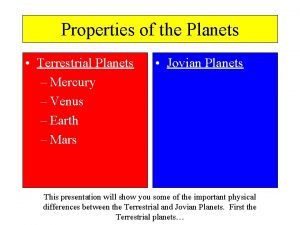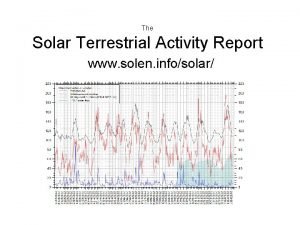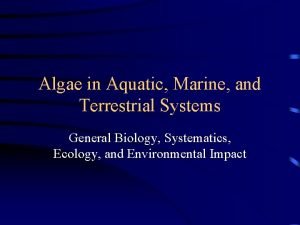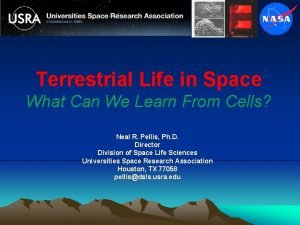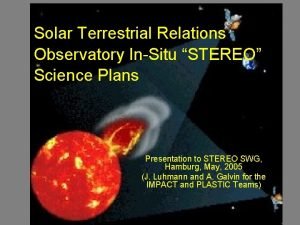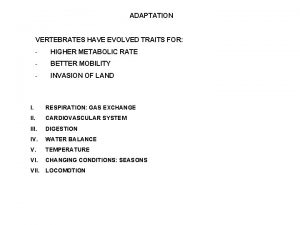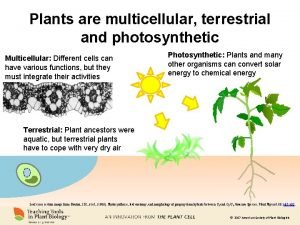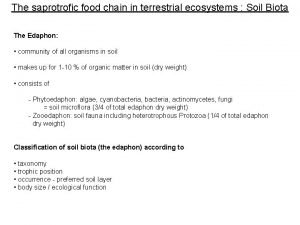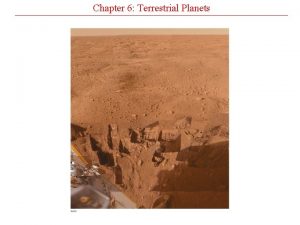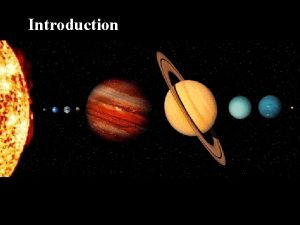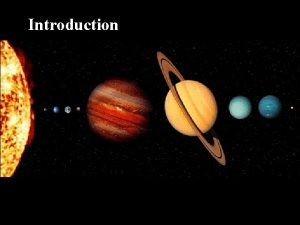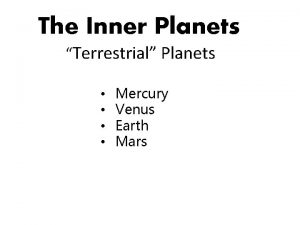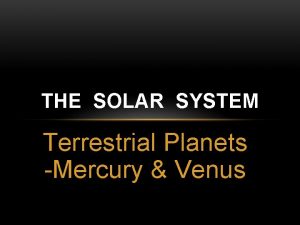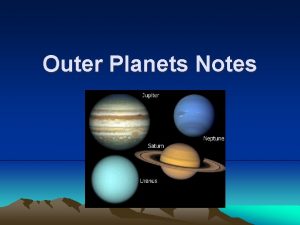Delivery of Volatiles to the Terrestrial Planets Hans






























- Slides: 30

Delivery of Volatiles to the Terrestrial Planets Hans Rickman Uppsala Astronomical Observatory

The Earth’s Water G More than 70% of Earth’s surface is covered by water G The mass of the oceanic and atmospheric H 2 O is ~1. 5 1021 kg G The Earth’s interior is relatively dry, but there may be several additional ocean masses of H 2 O in the mantle rocks G The total amount of water in the Earth may be ~6 1021 kg (~0. 001 ME)

Possible origins (standard) G Endogenous water - (“local water”, acquired from the Solar Nebula near Earth’s orbit) G Asteroidal water - (brought into the growing Earth from the asteroid main belt) G Cometary water - (brought into the full-grown Earth by a late cometary bombardment)

Against Endogenous Water G In an equilibrium condensation model for the solar nebula, water ice and hydrated minerals occur only at lower temperatures than expected for Earth’s formation region

Water in asteroids (1) G Fraction of asteroids showing the 0. 7 m band of the Fe 2+ Fe 3+ transition in hydrated minerals (proxy for OH) versus orbital semimajor axis (Jewitt et al, Protostars & Planets V, 2006)

Water in asteroids (2) G Three comets recently identified in the outer Main Belt (Hsieh & Jewitt 2006) existence of subsurface ice G Existence of dynamical routes from the Jupiter family into the Main Belt, in particular when the gas disk existed Hsieh & Jewitt (2006)

Water in meteorites G Carbonaceous chondrites contain ~3 -11% water as clay minerals and serpentines. They come from the outer MB. G Ordinary and enstatite chondrites have only ~0. 05 -0. 1% water or less. They come from the inner MB. Allende meteorite (carbonaceous chondrite)

Geochemical Data: D/H Ratios G D/H in VSMOW is ~6 protosolar and ~1/2 cometary G D/H in Martian meteorites is ~2 VSMOW (close to cometary) Drake & Righter (2002)

Geochemical Data: D/H Ratios G VSMOW may be a mixture of cometary and asteroidal H 2 O, possibly with some endogenous (protosolar? ) contribution G Caveats: - cometary D/H is measured only for Oort cloud comets and has important error bars - possible D/H fractionation at diffusion and sublimation of cometary H 2 O - martian D/H may have been raised by atmospheric erosion (cf. Venus)

Geochemical Data: Noble Gases G Kr/Ar in Earth and Mars is >> solar G Xe/Kr in Earth and Mars is << chondritic G All noble gases are much more abundant on Earth than Mars (martian atmospheric erosion) Owen & Bar-Nun (1996)

Geochemical Data: Noble Gases G Owen & Bar-Nun (1995): mixture of rocks (devoid of noble gases) and cometary ice (trapping ratios for condensation of amorphous ice at ~50 K) G Caveats: - observations of comets are lacking; their formation temperature may be different - the noble gases and the water may have different origins, if the former were degassed before the Moon-forming impact

Endogenous water (Drake & Campins 2006) G Pro – evidence for early H 2 O ocean (129 Xe/132 Xe ratio; zircons ~4. 3 -4. 4 Gyr) G BUT: there is an exogenous source predating this ocean G Pro – adsorption of H 2 O onto nebular grains (Stimpfl et al. 2004): depends on S/V ratio of grains, ~1 Earth ocean adsorbed at T~700 K for S/V~100(S/V)sph (Drake 2005) G BUT: the S/V ratio of real nebular grains is completely unknown

Exogenous water (Drake & Campins 2006) G Con – Stern et al. (2000) found solar Ar/O ratio in comet Hale-Bopp (tentative detection) G BUT: Weaver et al. (2002) found <10% solar Ar in two other comets; impact erosion may cause loss of Ar from the atmosphere G Con – 187 Os/188 Os of Earth’s PUM agrees with anhydrous but not carbonaceous chondrites G BUT: the late veneer now appears to have been mainly due to water-poor asteroids, not comets

The Osmium evidence G The PUM (primitive upper mantle) has a chondritic abundance pattern of highly siderophile elements assumption that this is due to the late veneer, after core formation Drake & Righter (2002)

The cometary late veneer G This used to be the standard explanation for the Earth’s water about 10 years ago but was first challenged by the discovery of an apparent discrepancy between the cometary and VSMOW D/H ratios G Later on, other more important shortcomings have been found

Giant Planet Formation: Classical Recipe G The cores of the giant planets formed in situ by planetesimal accretion time scales: ~ 106 yr for Jupiter ~ 108 yr for Neptune G Gravitational scattering into Earth-crossing orbits occurs on the same time scales long-lasting bombardment (decay time constant ~108 yr) from Neptune’s accretion zone

Lunar Cratering Rate G Suppose lunar cratering decayed exponentially with ~108 yr until the end of the heavy bombardment time-integrated impactor mass, scaled to Earth, from 4. 4 to 3. 9 Gyr ago: ~ 2 1022 kg (Chyba et al. 1995) Chyba (1991)

However, … G The picture of exponential decay has been increasingly challenged in favour of an episodic Late Heavy Bombardment G There are problems explaining the amount of impacting cometary material on dynamical grounds G New planetary formation models involve radial migration due to scattering of the planetesimal disk

Late Cataclysmic Cratering Episode G No trace of 600 Myr continual lunar cratering (no impact melt rock older than ~3. 9 Gyr in Apollo/Luna samples and lunar meteorites) G No crustal enrichment in siderophiles limits on total amount of impacts G No trace of large impact basins before ~4. 0 Gyr ago G Early oceans on Earth speak against an extremely high impact rate at early epochs G The total mass of LHB Earth impactors yields <10% of the Earth’s water

Dynamical Constraints (1) G Earth-crosser chance of hitting the Earth per orbital revolution: ~10 -8 G Earth-crossing lifetimes: - for asteroids from the MB ~106 orbits total impact chance ~10 -2 - for comets ~103 104 orbits total impact chance ~10 -5 -10 -4 (depends on probability of decoupling from Jupiter)

Dynamical Constraints (2) G To acquire ~10 -3 Earth masses of H 2 O from comets, ~10 100 Earth masses of potential impactors are needed G TOO MUCH, IF COMING FROM NEPTUNE; PROBABLY ALSO IF COMING FROM JUPITER-SATURN G To acquire the same from asteroids with ~10% water (CC), ~1 Earth mass of potential impactors is needed G MAYBE REASONABLE DURING THE FORMATION OF JUPITER

The “Nice Model” (1) G Start with a condensed system of giant planets G They scatter away all remaining planetesimals before the gas disk dissipates G Later migration due to eating away of the outer planetesimal disk J-S 5: 2 resonance crossing at the time of the LHB Gomes et al. (2005)

The “Nice Model” (2) G Strong dynamical instability! G Rapid clearing of outer disk heavy cometary bombardment G Migration of Jupiter and Saturn sweeping of secular resonances through the Main Belt heavy asteroidal bombardment G The LHB crater size distribution on the Moon agrees with MB size distribution of asteroids were likely dominant Gomes et al. (2005)

Early Exogenous Water G Clearing of the region exterior to the Main Belt by the growth of Jupiter G Clearing of the space in and between the giant planet accretion zones G Time scales: less than or ~a few 106 yr

Suggested delivery mechanism for Earth’s water G The growth of Earth-mass and larger planetary embryos in the Jupiter-Saturn zone led to the scattering of huge numbers of icy planetesimals (IPs) at a time when the gas disk (solar nebula) still existed G The IPs that were scattered into small perihelion distances got their orbits circularized by gas drag and ended up in the outer asteroid belt G Parts of the terrestrial planets may have been brought in from that region (CC meteorites)

Dynamical transfer routes G Blue curves (bidirectional): gravitational kicks at close encounters for different encounter velocities G Green curves (only toward the upper left): eccentricity damping by gas drag for different values of the angular momentum G The time scales for the two phenomena are similar for a certain IP size range

Terrestrial planet growth (1) G Wetherill (1992), Chambers & Wetherill (1998): G Runaway accretion of planetary embryos all over the inner SS contemporary with the growth of Jupiter G As Jupiter arises, the MB embryos are caught in resonances and their eccentricities are increased G Some are accreted by the embryos in the TP region, and the MB is efficiently depleted Petit et al. (2001)

Terrestrial planet growth (2) G Morbidelli et al. (2000): G Simulations show that, in general, the Earth should contain ~1 -2 embryos from the region at >2. 5 AU G If these are as hydrous as CC meteorites, then there is more than enough water for the Earth’s budget G Caveats: small number statistics, loss of water during accretion of embryos, loss of water during the final giant impacts

Tentative Conclusions G Some of the planetary volatiles may be of endogeneous origin G A rich exogenous source existed while the giant planets formed; H 2 O could have been brought to Earth both from outside and inside the snow line G The late veneer, including the LHB, was apparently unimportant for the delivery of volatiles

Final Question: G An early origin of the Earth’s volatiles makes them vulnerable to accretional giant impacts, including the Moon-forming impact G But the lack of a relevant late veneer to replace the lost water means that these impacts must not have desiccated the Earth G Can this be understood?
 How are terrestrial planets different from jovian planets?
How are terrestrial planets different from jovian planets? Inner terrestrial planets
Inner terrestrial planets The terrestrial planet
The terrestrial planet Terrestrial planets surface
Terrestrial planets surface Length of orbit on saturn
Length of orbit on saturn The inner solar system by leslie
The inner solar system by leslie What are the four outer planets called
What are the four outer planets called What separates the inner and outer planets?
What separates the inner and outer planets? Au2s nomenclatura tradicional
Au2s nomenclatura tradicional Accenture delivery suite policy
Accenture delivery suite policy Infosolar
Infosolar Are protists terrestrial or aquatic
Are protists terrestrial or aquatic Umts network architecture
Umts network architecture Human impact on terrestrial ecosystems
Human impact on terrestrial ecosystems Terrestrial soil
Terrestrial soil Navigation terrestrial
Navigation terrestrial Terrestrial life
Terrestrial life Solar terrestrial relations observatory
Solar terrestrial relations observatory Terrestrial food web
Terrestrial food web Terrestrial only
Terrestrial only My very excited mother just
My very excited mother just Respiration in terrestrial animals
Respiration in terrestrial animals Terrestrial biomes summary chart
Terrestrial biomes summary chart Are plants multicellular
Are plants multicellular Oie
Oie Terrestrial plant
Terrestrial plant Hydroponics is the science of growing terrestrial plants in
Hydroponics is the science of growing terrestrial plants in Food chain ladybug
Food chain ladybug Are bacteria autotrophs or heterotrophs
Are bacteria autotrophs or heterotrophs Terrestrial biomes characteristics
Terrestrial biomes characteristics Japygina
Japygina


